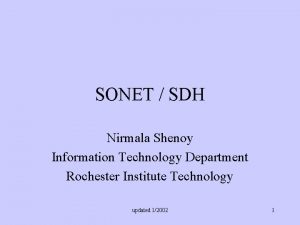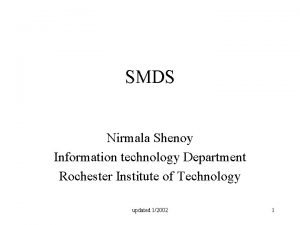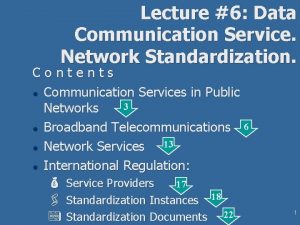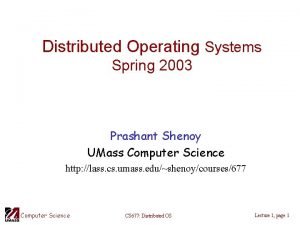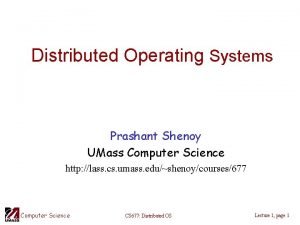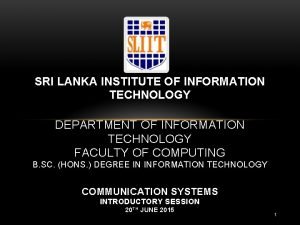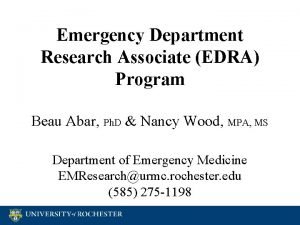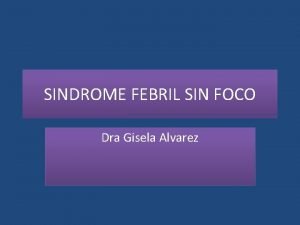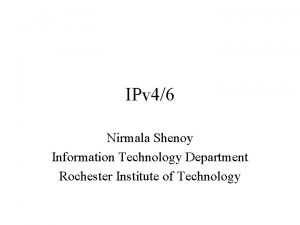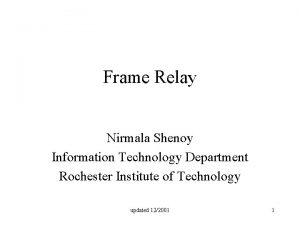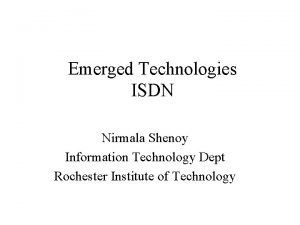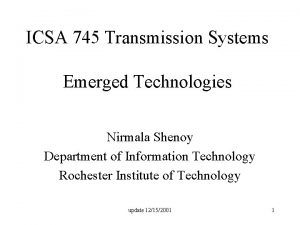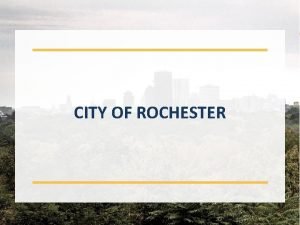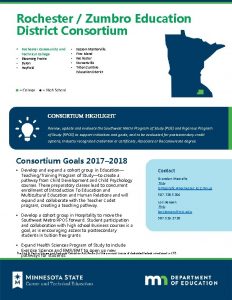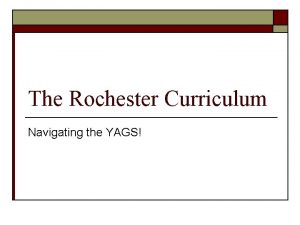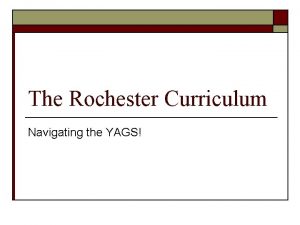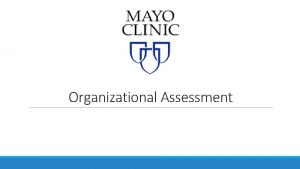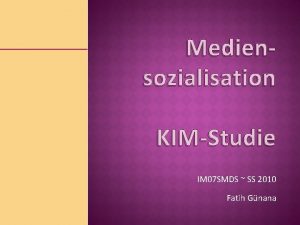SMDS Nirmala Shenoy Information technology Department Rochester Institute




















- Slides: 20

SMDS Nirmala Shenoy Information technology Department Rochester Institute of Technology updated 1/2002 1

SMDS • Scope – DQDB operation – SMDS Architecture updated 1/2002 2

DQDB • Uses MAN protocol – hence first briefly into DQDB • DQDB – Distributed Queue Dual Bus – 2 communication channels – Each station connects to both bus – Queues to use each bus – Queues carry information about other stations updated 1/2002 3

DQDB • Architecture updated 1/2002 4

DQDB • Architecture – Bus B • With respect to Station 3, Stn 1, and 2 are downstream • Stn 4, 5 are upstream – Bus A • With respect to Station 3, stn 4, 5 are down stream • Stn 1, 2 are upstream updated 1/2002 5

DQDB • Operation – On Bus A, head of bus A generates slots of 53 bytes which goes down bus A – On Bus B, head of Bus B generates slots which go down bus B – Empty slot travels down the bus, till a station wanting to transmit, sends its 53 bytes updated 1/2002 6

DQDB • Operation – Bus A: Stn 3 can send to 1 and 2 – Bus B, stn 3 can send to stn 4 and 5 – Upstream Node monopolization – Station to reserve for slots if they want to communicate to downstream nodes – Reservation goes in direction opposite to the direction you want to send updated 1/2002 7

DQDB • Operation – To book a downstream slot in Bus A, use the slots passing by in Bus B to the head of bus A – All upstream nodes in Bus A see the reservation going by – Keep an account of the number of reservations that go by – On empty slots going downstream A, the upstream station let that many slots go by updated 1/2002 8

DQDB • Operation – Distributed Queues • Queue A for Bus A • Queue B for Bus B – Queues hold the booking for slots – Each station puts a token in the queue when it sees a request going by – When it wants to send, it will put its token in the queue updated 1/2002 9

DQDB • Operation – As empty slots go by – Tokens are removed for each empty slot – Till – this station token is at Ho. Q – Empty slot comes by and is taken by this station • Ring configuration possible updated 1/2002 10

DQDB • DQDB layers – Physical – MAC layer • 48 byte payload • 5 byte header updated 1/2002 11

DQDB • DQDB MAC PDU – 5 byte Header • • • Access Address Type Priority CRC updated 1/2002 12

DQDB • Access field – 8 bits – Busy bit – slot is carrying data – Slot type – pkt transmission, isochronous transmission – Reserved bit – PSR – (Previous Slot Read) 2 bits – set to 0 once the destination stn has read – RQ – 3 bits – 8 levels of priority on request updated 1/2002 13

DQDB • Address Field – 20 bit VCI • Type field – 2 bits –payload type, user data, management data • Priority field – Priority of the slot • DQDB – self healing • Determination of upstream and downstream stations updated 1/2002 14

SMDS • SMDS – Packet switched datagram service for high speed MAN traffic – Switched service – pay for time of usage – Networks use Router to connect to SMDS switches using DQDB • SMDS Interface protocol - SIP updated 1/2002 15

SMDS • SMDS topology updated 1/2002 16

SMDS • SMDS - SIP Level 3 – Adds header and trailer – Header has sender and receiver address – Packet is segmented into 44 bytes – Each 44 byte is given 2 bytes header, 2 bytes trailer – 2 byte header updated 1/2002 17

SMDS • SMDS - SIP Level 3 – header – ST – 2 bits – segment type – 4 bits sequence count – Message ID – 10 bits – Trailer • 6 bit length indicator • 10 bit crc updated 1/2002 18

SMDS • SMDS - SIP Level 2 – DQDB • SIP level 1 – physical layer updated 1/2002 19

SMDS • Summary – Ease on geographic limits – Offers Switched services – Addresses high speed interconnectivity – End Systems are routers – Real-time? – Bulk data updated 1/2002 20
 Nirmala shenoy
Nirmala shenoy Nirmalaslot
Nirmalaslot Smds in dcn
Smds in dcn Rajani shenoy
Rajani shenoy Prashant shenoy umass
Prashant shenoy umass Ananth shenoy
Ananth shenoy Distributed os
Distributed os Sri lanka institute of information technology
Sri lanka institute of information technology Mutiyanganaya
Mutiyanganaya Department of information technology
Department of information technology Department of electronics & information technology
Department of electronics & information technology Latest electronics and information technology in odisha
Latest electronics and information technology in odisha Dr. fernando cosio rochester mn
Dr. fernando cosio rochester mn Edra rochester
Edra rochester Lattimore hall
Lattimore hall Sinantec
Sinantec Mbhs moodle
Mbhs moodle Eastman business park map
Eastman business park map Daniel stefankovic
Daniel stefankovic Rochester first time home buyer
Rochester first time home buyer çağrı safa buyurgan
çağrı safa buyurgan
